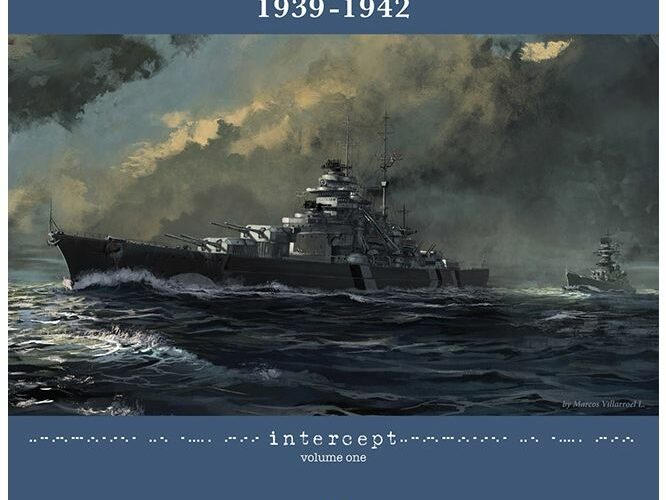Atlantic Chase Review

Hex-and-counter naval warfare games are nothing new, but the way Atlantic Chase tackles it is with a mechanism I’ve never seen before. For most of the game, your ships are in some kind of quantum state, which sounds ridiculous I know, and I’m almost certainly grossly misrepresenting quantum mechanics, but that’s where we are. Instead of pieces representing your navy, you have lines of wooden pieces running across the board which represent trajectories, and a trajectory in Atlantic Chase terms is basically a line in the ocean that says “my task force is somewhere along that line”. Here’s the kicker though – nobody, not even you, knows where it is. It exists everywhere and nowhere all at once.

Is your brain frazzled yet? No matter, I’m going to plough on regardless.
Interceptions and intersections
So let’s say for argument’s sake that your opponent has a trajectory on the board: a line of pieces which his task force of ships is somewhere along. If you choose to extend your own trajectory and intersect with theirs, then you open up the possibility of using a Naval Search action. After you’ve done the maths associated with the action (there are handy tables printed on the board, as well as player aids) you may well find that you’ve punched a hole in that enemy trajectory. When this happens everything on one side of that hole gets taken off the board, and it’s the player who punched a hold in it who decides which.
To put that into context, let’s say my opponent has a trajectory from Ireland to the coast of North America. The moment I punch a hole in that line, I decide which half of the ocean they’re in. If I remove everything to the west of my own wooden stick, it means their task force has to exist somewhere along the eastern half that remains. I don’t know where exactly, but I’m closing in, and if they were trying to escape that convoy to an American port, I’ve just made their job a whole lot harder.

To the uninitiated, it might seem like a really random way to do naval seek and destroy, but the reality is something much cleverer. This might sound stupid, but oceans are really big, and in comparison, ships are very tiny. The trajectory mechanism is a fantastic way to represent the difficulties these sailors faced in finding one another in the first place, let alone shooting at them.
It’s such an interesting mechanism, and it’s really hard to convey just how thoughtful and strategic it makes the game. It’s like hidden movement, but instead of moving to a place, you’re digging tunnels so that in future turns you could pop up anywhere along it, like some kind of aquatic mole. So we’re dealing with quantum, submarine moles – got it? All of this kiss chase is no good without some fisticuffs once you finally meet up, right? Maybe we played kiss chase differently to you, I don’t know.
Note to self: find better analogies.
You sank my battleship
When battles happen, they’re carried out on the side of the board on a dinky little battle area. It makes sense; the battles really are the side dish compared to the main course of the chasing. Combat is relatively simple as your various vessels push in and out of range taking pot-shots across a dividing line. A bit like a tennis court, with heavy hitters dropping into the net to unleash volleys, before retreating to a safe distance to see what comes back at them.

Battles are really satisfying. There’s loads of room for cunning tactics. For instance, when ships use the manoeuvre ability to change their range, they can produce smoke. When the smoke marker goes on the board it affects both the ships shooting out through the smoke, and those firing in, giving a -1 modifier each way. Not that useful you might think, but there are plenty of times when just surviving is your goal, and sometimes smoke can help you do exactly that.
With those two pieces of gameplay acting as the foundations of the game, everything else just bolsters and adorns it, and adds extra little niceties which pull the whole thing together. The different leaders your task forces can have with their rule-breaking abilities, the crap-ton of scenarios in the accompanying books, the way weather affects the game, and the way certain actions allow your opponent to snatch initiative away from you and interrupt your plans. With the right people, and those people understanding the game, Atlantic Chase is a thing of beauty.
Having the right people and having them understand are just two of a handful of wrinkles in the smooth finish.
Troubled waters
Learning Atlantic Chase isn’t exactly smooth sailing (sorry…). It’s a daunting thing to open a box and find five books and a total of 200+ pages facing you. Some of that is scenarios, some is chapter-and-verse rules, and a chunk is reserved for the tutorial book. Normally I’d have a bit of a moan if I found a game to be too impenetrable with its rules and lack of tutorial. In contrast, Atlantic Chase veers in the other direction. It introduces concepts and parts of actions one tutorial at a time, which means by the time you’ve finished them you’ve setup, played, and put away the pieces for ten separate tutorials, covering 51 pages of that book. I think it’s great that a tutorial goes to this level of depth, but it’s a) very time-consuming, and b) indicative of the level of intricacy and nuance the game dives down to at times. But it’s there in the first place, and it works, and that’s worth a lot in my book. It’s an easier learn than something like Salerno ’43 (review here).

Atlantic Chase isn’t a game to play casually or to teach to someone who might only play once or twice. Learning the game is an investment, make no mistake. To get the most out of the game you need a regular partner to play games with, because it’s a two-player game. There are solo scenarios, and the solo does play a decent game, but it’s the mind games which make this game as much fun as it is, and that’s just not as much fun when it’s only your mind in the game. I can imagine having a wargame-loving friend who I meet up with regularly and having an absolute blast with Atlantic Chase, playing through scenario after scenario. If you go into it with a “dip in, dip out” mindset, you’re not going to get the most from it. I really enjoy playing Atlantic Chase and I’ve had great fun with the scenarios, but you need that wingman. You need that Goose to your Maverick. I’m sad and Gooseless.
I’ll admit right now that I haven’t tackled the campaign, just because I don’t have the time with another person to be able to do it, and that makes me sad. I’m also not keen on some of the random chance events in the game when they crop up. The first scenario for example, has you roll a dice if you manage to get the German cruise ship The Bremen to Murmansk before war breaks out. The scenario ends either way, but on a roll of 1 Russia captures it, and anything else sees it refuel and join the Kriegsmarine as intended. Rolling a 1 would be a damp squib of an ending for the Axis player. A similar thing happens to close some Axis ports in the campaign (hey, I can read it and dream, okay), which could see you get to a port and find out that someone’s rolled a die and it’s shut for the weekend, and you’re stuck there until it opens, like falling asleep in your car after going to B&Q at a retail park on Sunday afternoon.
Final thoughts
What a double-edged sword Atlantic Chase is. On one hand, you’ve got this incredibly tense game of hidden-movement cat and mouse, using what for me is a groundbreaking mechanism. It’s ridiculously good fun, and far more accessible than many hex-and-counter wargames. Yet on the other hand to really squeeze that juice from it, to get all the fun that comes in that cardboard box, you really need the right person on the other side of the table. You could argue that that’s true of any wargame, but the trajectory mechanism, brilliant though it is, takes at least a full game to really start to intuit.

The rule and scenario books are really well-written, and while it might put some people off, I’m a big fan of the conversational style used in them. It’s another little touch which makes the whole thing feel slightly friendlier and more welcoming to newbies. The counters are a decent size too, so when it comes to conducting battles, you don’t need tweezers. It’d be remiss of me not to mention the little wooden trajectory markers. Each country’s task forces use a specific colour of stick for the trajectories, and each colour has three different kinds of stick, for each of the three possible task forces. Each task force’s sticks are differentiated by one or two stripes printed on them, which would be great, but they’re only printed on one side! Flipping them around to see which belongs to which is a royal pain in the backside, and I’d dearly love to see this fixed in future printings (please!!!).
If you’re okay with all of that though. If you don’t mind the learn and the teach, if you have a regular player two, and if you’re smart enough to bag each set of sticks separately (…), Atlantic Chase is an amazing game. The hidden movement is so, so clever, so unique, and so much fun to apply. The choice of how long to make each trajectory is exquisitely painful. Too long and get broken quickly, too short and it takes twice as long to get anywhere. The chase when someone breaks the line and hightails it to safety is brilliant. They’re all things which precious few games manage to evoke in quite the same way. I’ve heard good things said about designer, Jeremy (Jerry) White, and if Atlantic Chase is anything to go by, they’re all correct. A stunning piece of game design, muzzled slightly by its dependencies.
Review copy kindly provided by GMT Games. Thoughts and opinions are my own.

Atlantic Chase (2021)
Design: Jeremy White
Publisher: GMT Games
Art: Jeremy White
Players: 1-2
Playing time: 30-120 mins














AC is currently sitting on my shelf of shame. Your excellent review and useful advice means i’ll not just treat it as a solo game and will track down an opponent from the landlubbers in my gaming group.